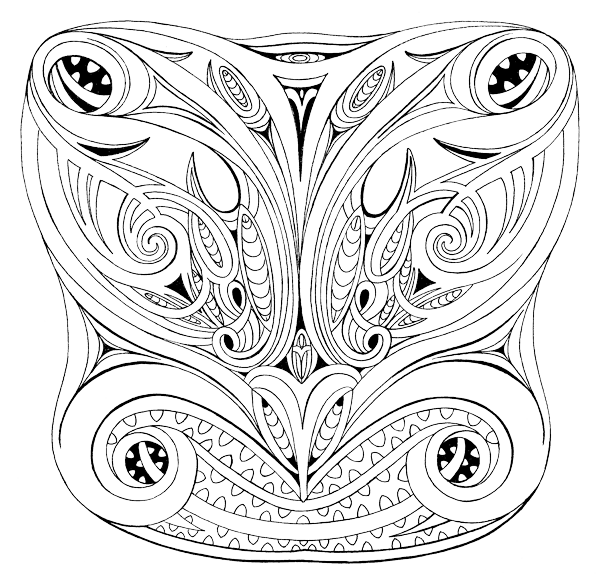
Since the WaiRestoration Hui in Northland in 2018 this project has continued to strengthen and more Enviroschools around the country are collaborating with their wider communities towards healthy waterways.
About 50 people from across New Zealand gathered in Kerikeri for the country’s first Enviroschools WaiRestoration national hui in March 2018 to explore WaiRestoration – a project that focuses on getting young people and their communities working together to restore local waterways and biodiversity. It was conceived by the Northland Regional Council’s Enviroschools team with the support of Toimata Foundation and was developed to become a model that can be adapted by other regions. Northland organisations, tangata whenua, students and teachers, farmers and landowners were among those who shared their WaiRestoration experiences with participants who came from as far afield as Otago.
There are seven elements at the heart of the Enviroschools WaiRestoration project: WaiFencing (keeping stock out of waterways); WaiNurseries (growing riparian plants); WaiPlanting (planting beside waterways); WaiMaintenance (keeping out plant and animal pests); WaiMonitoring (testing and tracking water quality); WaiEnterprise (creating sustainable employment); and Save a Species (restoring endangered plants and animals).
“It’s fantastic that we’ve been able to get together with similarly enthusiastic colleagues from around New Zealand and share what we’ve learned about successfully collaborating with our many communities to improve our waterways,” said Enviroschools Regional Co-ordinator Susan Karels about the hui.
Updates in 2019 from around the motu:
Te Taitokerau / Northland
Susan provides this information about how the project has been maintained and grown over the last year.
Engagement: There are now 64 Enviroschools (58%) involved in 1 – 6 streams of the WaiRestoration project in Taitokerau / Northland.
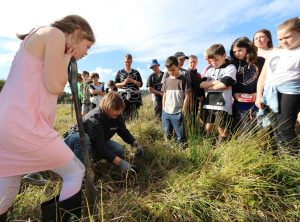
NRC Regional Councillor Joce Yeoman looks on as Jacki Byrd, NRC Land Management advisor demonstrates good planting technique.
Catchment Groups: The Northland Regional Council’s Mangere, Waitangi and Whangārei Catchment Groups have joined with Enviroschools in the pursuit of WaiRestoration. The catchment groups decided to put funding into joint school/catchment group WaiPlanting days, school WaiNurseries to grow riparian plants for local landowners, tracking and trapping equipment to keep out plant and animal pests from riparian areas, in-school WaiNurseries expert support and signs to inform people about the importance of inanga. Doubtless Bay Catchment Group is looking at doing similar in 2019.
Waitangi River Networking Event: Enviroschools team members participated in the Waitangi Catchment Group’s event – Waitangi River Networking Event. The team made a presentation and secured 12 local landowners who are keen to work with schools on the Enviroschools WaiRestoration project.
WaiFencing: Valuable knowledge and practical skills were gained by participants in three WaiFencing courses held last year at Pāmu Farms of New Zealand (formerly Landcorp) at Kapiro, Rangiputa and Titoki stations. Three waterways were fenced by the end of the course which included skills workshops and assessment days leading to NCEA Unit Standards. The participants were shown how to build fences and given practical experience in wire knots and ties, strainer assemblies, and electric fencing and battening. Feedback was very positive, with students commenting on the excellence of the tutors, the new things they had learnt and how fences exclude stock from waterways. We look forward to three further courses this year.
Freshwater Improvement Fund (FIF) Dune Lakes Project: The Enviroschools team and Jo Murray, Maruwai for Toimata Foundation, are jointly planning the implementation of the education arm of the Northland Regional Council’s FIF Dune Lakes Project. The education work plan first concentrates on identifying the current situation as school / kura communities get to know and connect with their lakes. They will do this by mapping the landscape, participating in sensory activities, hearing from local experts – kaumatua, scientists, land owners and community members – getting involved in riparian planting and having fun in and around the lake (recreation).
One Billion Trees Programme
Northland Regional Council’s Land Management Team including the Afforestation Advisors, Catchment Groups and Enviroschools are planning joint WaiPlanting days accessing plants from the One Billion Trees Programme.
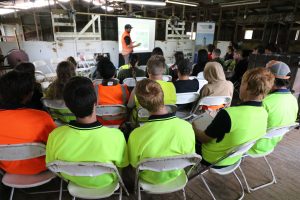
NRC Land Management Advisor, Michael Mitchell, explains why fencing waterways is so important to a group of students.
Te Tairawhiti/ Gisborne
Kirsty and Kauri are 2 motivated facilitators from Te Tairawhiti/ Gisborne that attended the WaiRestoration hui. They returned from the hui buzzing with ideas of how a similar approach could be taken in their region – ways that would respond to their specific catchment and community situation. Here they tell us about their project:
“We have been working hard for a few years to engage our Enviroschools in Tairawhiti in stream restoration. We had a very inspiring trip to Kerikeri earlier this year that helped make this happen. Huge mihi to Jo Graham from GGHS and Caron Taana from Te Waha o Rerekohu School for attending this hui with us. “The kaupapa of WaiRestoration is all about engaging young people and local communities in the restoration of waterways and biodiversity” said facilitator Kirsty Gaddum.
Our first awa is the beautiful Waikanae Stream, named after the kanae (mullet) that used to be plentiful. We started off with Waimonitoring with Amy Hardy from Nga Mahi Te Taiao. Students from GGHS, GBHS, Campion College and Te Karaka Area School have all tested the water for pH, temperature, clarity and conductivity. Best of all was fishing in the stream for macroinvertebrates. These little creatures give us an indication of water quality, ones like mayflies only live in good quality water. Unfortunately, we found large amounts of gambusia (mosquito fish) and snails which all indicate low water quality.

Waimonitoring day at the Waikanae awa.
Students immediately identified that the paddocks that ran down to the stream by Gisborne Airport should be fenced off from stock. Thus, Waifencing began with the wonderful tutors from Turanga Ararau. Our students have fenced off approximately 500m to date, of the upper Waikanae Stream so that the cows and horses don’t have access to the stream anymore. This will prevent bank erosion, sediment running into the stream, excess nutrients entering the water and shade the stream so more dissolved oxygen is in there. Our 8 wire fences have been funded by Gisborne Airport. Our students also gain NCEA credits for their hard work. With the stream now fenced off, a large community planting day took place on Friday 3rd of August with students, community members and staff from Gisborne Airport, Eastland Port and Eastland Group. 1300 native trees were planted which were funded by Gisborne Airport and 250 trees donated by Women’s Native Tree Project, which were all mulched with carpet, newspaper and bark.”
Hanah Veitch Gisborne High School: ”This stream isn’t just a stream. It has connections to the marae up there and once the community sees all these projects they’ll become more aware and more projects will begin and it’ll spread through-out the community. it’s really rewarding and along with all the new skills that I’ve learnt, it met a whole lot of new people and made new connections. ”
“With more trees, biodiversity in the area will increase so Waimaintainance has already started. The Department of Conservation has helped set out rat and stoat traps to catch any predators. Reported sightings of the matuku (bittern) in this area will benefit from trapping. Check out this new project when you drive to the airport next time, to the left and right off Aerodrome Road.”
Marlborough
Anna Crowe, one of the facilitators engaged in this kaupapa in Marlborough provides the following update:
“The WaiRestoration Hui inspired me to develop a ‘menu’ of ways that schools can get involved in helping to improve the water and habitat quality of the Taylor River – a river which flows right through the centre of Blenheim. This river is an ideal focus, as many of our local schools are within its catchment, and it is currently the focus of a broader council project to improve the water quality, mainly through riparian planting projects. School groups have been involved in monitoring the river (carrying out stream studies) for many years, and the plan is to continue with these sessions, but to then offer these school groups the chance to follow up the stream study sessions with some kind of action to help the river and river reserve area.
On the menu are:
- grow native plants at school, or plant native plants in selected riparian areas;
- maintain a recently planted area by learning about common weed species and carrying out regular monitoring;
- be a voice for the river. Encourage planting on privately-owned land with a river boundary; spread awareness about a special native species that lives in the river; participate in the writers’ walk poetry project; plan/paint/add to a mural);
- learn about and/or take action to improve stormwater quality and reduce rubbish in the river;
- adopt a part of the Taylor River catchment, by agreeing to care for a reach of the river;
- fencing part of the riparian zone: an option for senior secondary students, if there is interest.
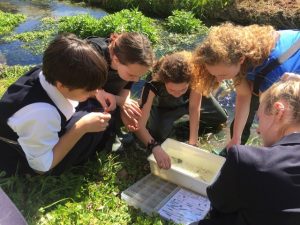
Marlborough Girls’ College studying stream life.
A number of schools have been involved in stream studies in the Taylor River catchment this year, and several have followed up by taking action. All of Bohally Intermediate School (over 400 students) took part in stream studies this year, and they took action afterwards by carrying out riparian planting beside their school stream, which is part of the Taylor River catchment. The Environmental Sustainability class at Marlborough Girls’ College also studied the water quality of this stream (they are located on the other side of the same stream) and began collecting data for what will be a long-term study of the health of the river and newly planted riparian zone. Year 10 MGC students learnt about how riparian planting can improve water and habitat quality and took part in a planting day on their side of the river. Several classes from Marlborough Boys’ College carried out stream studies this year, and a large group of students carried out a clean-up of the Taylor River and Taylor River Reserve area during ‘Clean Up Week’. A Year 10 MBC science class carried out a successful ‘Bioblitz’ in and around the Taylor River. Junior students at Richmond View School learnt about stormwater with the Drain Game and took action for the Taylor River by putting blue fish on the drains at their school, which flow into the Taylor River. Blenheim School students carried out stream studies in the river, and now carry out regular ‘womble walks’ to clean up the river reserve. They are very keen to adopt a reach of the river in 2019.
I look forward to growing this programme with our Blenheim schools this year, encouraging them to help the river in some way, once they have learnt about the special animals that live there.”
Otago
“We have a lot of schools interested in water and we ran a teacher hui on Water of Life Theme Area in the Central Otago area and a primary school hui focused on water in Dunedin last year,” reports Robyn Zink, Regional Coordinator. Quite a few Otago schools are using their local streams as part of their learning inquires this year as a result of these hui. “We are connecting with more people interested in water and those who can support schools and Enviroschools with expertise. We also have a lot of schools engaged in work on biodiversity and there are some schools who are well connected with their community projects (which we are supporting).
We have had to focus on team development recently with four new facilitators in Otago in 2018 and changes in the Regional Council staff as well. All this has influenced priorities and the ability to maintain a fully holistic approach.
The WaiRestoration hui and PD has made us think more broadly about the things we are doing and to be looking for opportunities to connect with wider community projects or for schools to be working together on bigger projects. The resource does, however, provide an excellent framework to conceptualise projects and looking for opportunities to join some dots together. While we have not been able to emulate the wai restoration project to date, we do refer to the resource and our learnings from the hui regularly when we get together as a team and are actively trying to think more long-term when schools identify water or biodiversity as their topics of inquiry.”
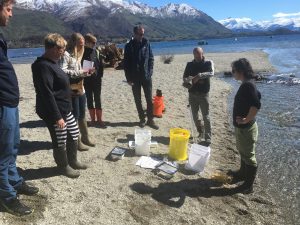
Otago teachers’ workshop – learning how to use the SHMAK kit
Canterbury
“After the hui. we followed up with a presentation to a group of managers at ECAN who responded positively so we hope further investment will come. Enviroschools WaiRestoration is, however. reaffirming of the work we are already doing in Canterbury and the hui encouraged wider discussion, raised the profile of Enviroschools and what might be possible with further investment. i.e. Waifencing especially and connection with land owners. It’s still on my vision!” says Regional Coordinator, Andrea Taylor.
Meanwhile, facilitator, Matt Stanford has continued supporting Lincoln High School in a range of science project-based learning. It has synergies with the Northland Enviroschools WaiRestoration approach and responds to this particular interest and situation. Pest trapping, aerial weed monitoring, wētā ‘motels’, and lizard habitats are some of the biodiversity projects year 10 students from Lincoln High School developed at a local reserve. A partnership approach was adopted where invited experts shared their role, field work skills, monitoring tools and the wider context behind their passion and career choice in a classroom session. This was followed by a second session at the reserve, where students practised fieldwork skills. This built the skillset and exposed the students to a varied range of fields in order to nurture a passion for one. After the experts had shared, the students got the chance to pick an area of interest and develop a longer-term monitoring strategy using their newly honed field work skills. After a few weeks the groups and experts came back together, data was collected and shared on an iNaturalist Project- a step to future proof the project. Actions were developed into proposals and presented to the Lincoln Envirotown Mahoe Reserve Committee, where feedback was received and permissions granted (with conditions!). The student actions included building a hedgehog proof lizard area where both skinks and their predating foe hedgehogs had been detected using tracking tunnels, running a trap line, to trialling a Borax weed killer for Convolvulus.
Nelson
From Nelson City, Joanna Wilson reports: “Hira School have been engaging with the Wakapuaka Project, part of Nelson City Council’s Healthy Streams programme. Nelson Enviroschools has been trialling several areas of the WaiRestoration model with the school, with support of Council staff (not involved in the Enviroschools programme) who attended the WaiRestoration Hui. It is still too early to gauge the success of this trial, however good relationships have been formed because of the WaiRestoration hui and we expect these to grow further”.
Waikato
Ruairi Kelly, Enviroschools Regional Co-ordinator in Waikato has provided the following information for his region.
“After the hui in Northland a project manager was hired for one year to look at options to implement a WaiRestoration like programme in the Waikato based on the Waikato specific community interests and needs.
A project management plan was subsequently developed and an internal stocktake was done to gain insight into what information was already available in the organisation, who is working with schools or community on restoration of waterways and biodiversity and how and who would be able to be part of WaiRestoration type projects (what works, what does not yet work and what are the opportunities). Pilot areas where identified and a document was developed with considerations for the pilots. In one of those pilot areas we are meeting with schools and are working towards co-designing the pilot with the schools and wider communities. However, since the project manager has now resigned, developments around the other pilot area are currently on hold. The Waikato Enviroschools programme continues to engage with a wide number of schools in their efforts within the seven streams of WaiRestoration, whether it be water monitoring, biodiversity restoration and riparian planting or pest management.
Mahi Ngā Tahi
With the benefit of the experiences from Northland and the WaiRestoration Celebration booklet, each region has been able to identify current engagement in waterway restoration and plan for learning and action appropriate to their place. Enviroschools around the country are collaborating with their wider communities towards healthy waterways.
